Alaa Nabil El-Hazek
Department of Civil Engineering, Faculty of Engineering at Shobra, Banha University, Cairo, Egypt
Correspondence to: Alaa Nabil El-Hazek, Department of Civil Engineering, Faculty of Engineering at Shobra, Banha University, Cairo, Egypt.
| Email: |  |
Copyright © 2014 Scientific & Academic Publishing. All Rights Reserved.
Abstract
This paper aims to achieve optimum design of storing water through dams, and also to predict the storage unit cost through dams. The storage unit cost means the cost for storing 1 m3 of water. For these objectives, data are collected for forty dams that were constructed in Al-Baha, Saudi Arabia, for storing water from 1975 till 2012. For the optimum design of storing water according to the required capacity, it is concluded that considering the type of the required dam gives more accurate results. For earth fill dams, the water capacity does not matter. While for concrete dams, the water capacity of 4 million m3 is significant. An equation is obtained to get the optimum design of storing water through earth fill dams. Two equations are obtained to get the optimum design of storing water less than and more than 4 million m3 through concrete dams. Concerning the storage unit cost of water through dams, it is concluded that introducing the type of the required dam gives only slightly more accurate results. An equation is obtained to predict the storage unit cost of water through dams regardless the type of the dam. Also, two equations are obtained to predict the storage unit cost of water through earth fill dams. Finally, an equation is obtained to predict the storage unit cost of water through concrete dams.
Keywords:
Optimization, Water Resources, Unit Water Storage, Dams, Regression
Cite this paper: Alaa Nabil El-Hazek, Optimum Design of Storing Water and Predicting Storage Unit Cost in Al-Baha, Kingdom of Saudi Arabia, American Journal of Environmental Engineering, Vol. 4 No. 5, 2014, pp. 99-105. doi: 10.5923/j.ajee.20140405.03.
1. Introduction
Storing water for later use is essential for Kingdom of Saudi Arabia, KSA, as there are no natural surface water resources. KSA, west of Asia, is classified among arid regions. It has neither rivers nor lakes. The main water resources in KSA are ground water and rain water falling only in some provinces. Rain ranges between 110 mm/year and 300 mm/year on the western south provinces. The flowing rain water is estimated, in the year 1998, to be approximately 5,000 million m3/year, 60% of them occur on the western south provinces. A small part of this water feeds the ground water reservoirs, while the other part flows to the red sea, west of KSA.Water resources in KSA in the year 2014 are 16,307 million m3, [1]. These various resources are summarized as percentage ratios of the total amount and are shown in figure 1. It is a good trend to treat water collected after being used for both municipal and industrial purposes, the sewage water, and agricultural purposes, the drainage water. Also, it can be noted that the treated sewage water is much more than the treated drainage water. That is due to the limited surface irrigation systems and the nature of sandy soil. | Figure 1. Water Resources in KSA |
Depending on the non-renewable ground water, confined ground water with no recharge, as a main resource of water is a critical situation. Uses of water in KSA are set to be equal to the available water resources, [1]. These different uses are summarized as percentage ratios of the total amount and are represented in figure 2.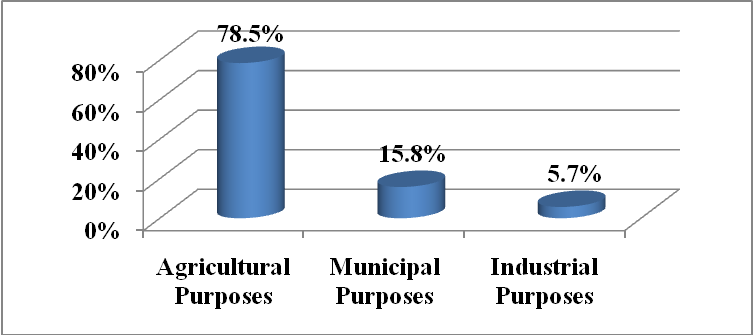 | Figure 2. Uses of Water in KSA |
Dams as a tool for storing water are widely constructed in different provinces of KSA for irrigation purposes, recharge wells downstream the dams, potable water supply, and protection against dangerous floods. The types of dams in KSA are concrete, earth fill or rock fill and underground dams.The total amount of stored water in KSA is 1,354 million m3 through 302 dams in the year 2009 in all provinces, [1].It is planned to increase the stored water to be 2,500 million m3 in the year 2014, [1].
2. Storing Water in Al-Baha
Al-Baha is a province located on the western south of KSA. It contains six governorates in addition to Al-Baha city. It has the smallest area among the provinces of KSA with a total population of about 430,000 capita.Water budget for Al-Baha province is 143 million m3 in the year 2014, [1]. These amounts of water represent only 0.88 % of the total water budget of KSA. Figure 3 illustrates uses of water in Al-Baha province as percentage ratios of the total amount for the year 2014.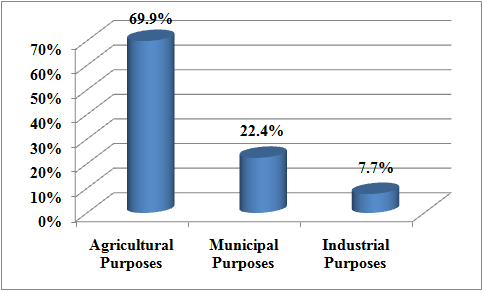 | Figure 3. Uses of Water in Al-Baha Province |
Comparing figures 2 and 3, it can be noted that the quantity of water used for agricultural purposes in Al-Baha province is less than that used in KSA. This may be due to the mountain nature of Al-Baha. This paper aims to achieve the optimum design of storing water according to the required capacity, and also to predict the unit cost for storing water through dams. The unit cost means the cost for storing 1 m3 of water.For these objectives, storing water through dams in Al-Baha province is reviewed during about 37 years, specifically from 1975 till 2012. Data are collected for forty dams that were constructed in Al-Baha province during this period, [2] & [3]. The data are tabulated ascending according to the water capacity, as shown in table 1, appendix A. The purposes of the forty dams are illustrated as percentage ratios in figure 4. The recharge dams are used for storing water to recharge the ground water, the potable dams are used for water supply purposes, the control dams are used for directing water to the desired directions, and the irrigation dams are used for agricultural purposes. 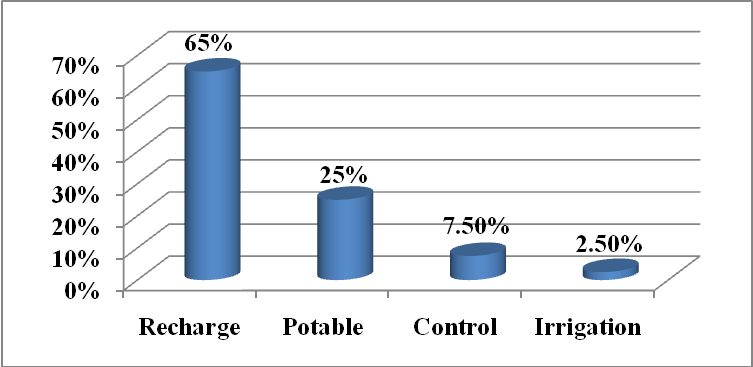 | Figure 4. Purposes of Dams in Al-Baha Province |
The types of the forty dams are illustrated as percentage ratios in figure 5. The earthfill dams depend mainly on rocks, while the concrete dams depend mainly on plain and reinforced concrete. 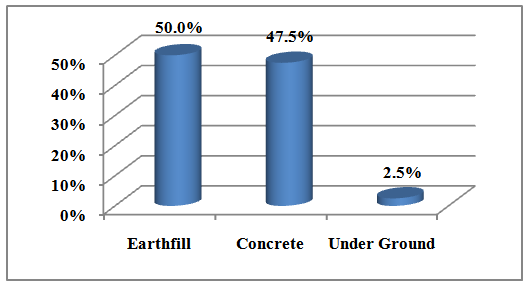 | Figure 5. Types of Dams in Al-Baha Province |
3. Analyses of the Data
It is obvious from the collected data that the costs of dams are of different years. To analyze these data, a datum year is fixed for all costs. That is the current year. The present values for these costs in the current year, 2014, are definitely different. That is to say that if these dams are to be constructed this year, their costs will be different. That is correct due to the inflation rates that lead to decreasing the value of money along the years. That refers to a general rise in prices measured against a standard level of purchasing power.Introducing the inflation rates, the costs in 2014 are calculated using the simple equation: | (1) |
Where,C 2014: the cost in the current year, 2014.IC: the cost in the year of constructing the dam.i: the inflation rate.n: number of years from construction till the year 2014.The inflation rate (i) is considered to be 1.25%, [4], as an average for the studied years. The data of C 2014 for these dams are shown also in table 1, appendix A.It has to be mentioned that the costs of dams are collected in Saudi Riyal which is the currency of KSA. One American dollar is equal to 3.75 Saudi Riyal, [5]. To achieve the first objective of this paper concerning the optimum design of storing water according to the required capacity, the cost C 2014 is plotted versus the water capacity for all dams. Then regression analyses are done employing micro soft excel software. Equations are obtained to get the optimum design of storing water.To achieve the second objective of this paper concerning the storage unit cost of water through dams, the costs C 2014 are divided by the corresponding water capacities to get the costs for storing 1 m3 of water. The data of the storage unit cost of water for all dams are shown also in table 1, appendix A. Similarly, the storage unit cost is plotted versus the water capacity for all dams. Then regression analyses are done employing micro soft excel software. Equations are obtained to predict the storage unit cost of water through dams.It has to be referred that there are many regression analyses through micro soft excel software. In this paper, the chosen type of regression is that associated with the highest value of correlation factor R2, as possible.
4. Optimum Design of Storing Water
It was found that the type of the dam has no effect on the cost for the dams with storage capacities less than or equal 500,000 m3, [6]. Also, the type of the dam has to be taken into consideration for the values more than 4 million m3 to get the optimum water storage, [7].However, in this study, the data of 40 dams for storing water are reviewed. It is noticed that there are five dams with the same capacity of 100,000 m3. Also there are three dams with the same capacity of 200,000 m3. Taking the average cost associated with these two values of water capacity, the number of dams is reduced to be 34 dams.Figure 6 illustrates the cost C 2014 versus the water capacity for all 34 dams. Then regression analyses are done employing micro soft excel software, as shown also in figure 6. It is obvious that the exponential regression with R2 of 73.7% is better than the linear regression with R2 of 68.6%.  | Figure 6. Cost C 2014 versus Water Capacity for all 34 Dams |
However, the obtained equation to get the optimum design of storing water is: | (2) |
Where:C: The optimum cost, Saudi riyal.WC: Water capacity, m3. Although the value of obtained correlation factor R2 is not high, this equation may be used to get the optimum design of storing water.To reach better results, the types of dams for storing water are introduced into consideration. The gathered data contain 20 earth fill dams, 19 concrete dams, and only 1 underground dam.The underground dam will be disregarded as it is only one dam, and both the earth fill dams and the concrete dams are going to be studied.Concerning the 20 earth fill dams, it is found that there are two dams with the same capacity of 200,000 m3. Taking the average cost associated with this value of water capacity, the number of dams is reduced to be 19 dams.The cost C 2014 versus the water capacity for the earth fill dams is shown in figure 7 that includes also the trend line obtained from the linear regression analysis.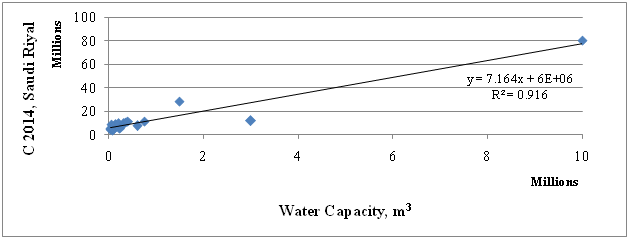 | Figure 7. Optimum Design of Storing Water through Earth Fill Dams |
The obtained equation to get the optimum design of storing water through earth fill dams is: | (3) |
Where:C: The optimum cost, Saudi riyal.WC: Water capacity, m3. This equation can be used effectively to get the optimum design of storing water through earth fill dams.Concerning the 19 concrete dams, it is found that there are four dams with the same capacity of 100,000 m3. Taking the average cost associated with this value of water capacity, the number of dams is reduced to be 16 dams.The cost C 2014 versus the water capacity for the concrete dams is shown in figure 8 that includes also the trend line obtained from the linear regression analysis. | Figure 8. Cost C 2014 versus Water Capacity for the Concrete Dams |
The obtained equation to get the optimum design of storing water through concrete dams is: | (4) |
Where:C: The optimum cost, Saudi riyal.WC: Water capacity, m3. Although the value of obtained correlation factor R2 is not high, this equation may be used to get the optimum design of storing water through concrete dams.From figure 8, it is obvious that the value of water capacity of 4 million m3 is significant with respect to the associated cost. The concrete dams are divided into two groups of dams. The first group includes the dams with water capacity less than 4 million m3. This group contains the first eleven dams. The second group includes the dams with water capacity more than 4 million m3. This group contains the other five dams.For the two groups of concrete dams, the cost C 2014 is plotted versus the water capacity, as illustrated in figures 9 and 10 respectively. Each figure includes also the trend line obtained from the regression analysis employing micro soft excel software. 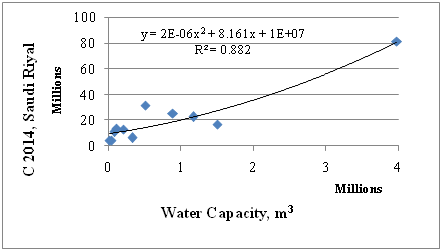 | Figure 9. Optimum Design of Storing Water Less than 4 million m3 through Concrete Dams |
 | Figure 10. Optimum Design of Storing Water More than 4 million m3 through Concrete Dams |
The obtained equation to get the optimum design of storing water less than 4 million m3 through concrete dams is: | (5) |
Where:C: The optimum cost, Saudi riyal.WC: Water capacity, m3. This equation can be used effectively to get the optimum design of storing water less than 4 million m3 through concrete dams.Similarly, the obtained equation to get the optimum design of storing water more than 4 million m3 through concrete dams is: | (6) |
Where:C: The optimum cost, Saudi riyal.WC: Water capacity, m3. This equation can be used effectively to get the optimum design of storing water more than 4 million m3 through concrete dams.
5. The Storage Unit Cost
The second objective for this paper is to predict the storage unit cost of water through dams that means the cost for storing 1 m3 of water. Figure 11 illustrates the storage unit cost versus the water capacity for all 34 dams. Then regression analysis is done employing micro soft excel software, as shown also in figure 11.  | Figure 11. Storage Unit Cost versus Water Capacity for all 34 Dams |
However, the obtained equation to predict the storage unit cost of water through dams is: | (7) |
Where:Uc: The storage unit cost, Saudi riyal.WC: Water capacity, m3. This equation can be used effectively to predict the storage unit cost of water through dams.For more investigation, the types of dams for storing water are introduced into consideration. The storage unit cost versus the water capacity for the earth fill dams is shown in figure 12 that includes also the trend line obtained from the regression analysis.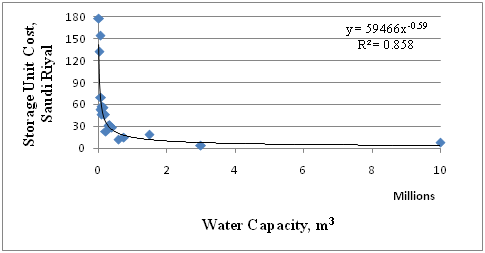 | Figure 12. Storage Unit Cost versus Water Capacity for all Earth Fill Dams |
The obtained equation to predict the storage unit cost of water through earth fill dams is: | (8) |
Where:Uc: The storage unit cost, Saudi riyal.WC: Water capacity, m3. This equation can be used to predict fairly the storage unit cost of water through earth fill dams.There is a gap between the last two earth fill dams with respect to the water capacity. Excluding the last earth fill dam, the regression analysis becomes more precious as shown in figure 13. | Figure 13. Storage Unit Cost of Water through Earth Fill Dams with Water Capacity Up to 3 million m3 |
The obtained equation to predict the storage unit cost of water through earth fill dams with water capacity up to 3 million m3 is: | (9) |
Where:Uc: The storage unit cost, Saudi riyal.WC: Water capacity, m3. This equation can be used effectively to predict the storage unit cost of water through earth fill dams with water capacity up to 3 million m3.Similarly, the storage unit cost versus the water capacity for the concrete dams is shown in figure 14 that includes also the trend line obtained from the regression analysis.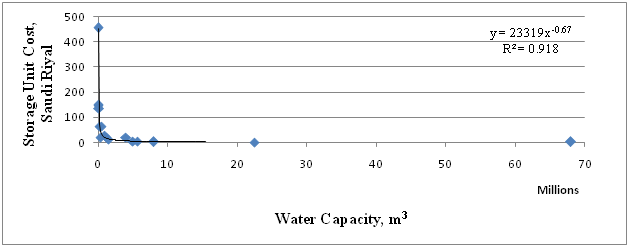 | Figure 14. Storage Unit Cost of Water through Concrete Dams |
The obtained equation to predict the storage unit cost of water through concrete dams is: | (10) |
Where:Uc: The storage unit cost, Saudi riyal.WC: Water capacity, m3. This equation can be used effectively to predict the storage unit cost of water through concrete dams.
6. Conclusions and Recommendations
For the optimum design of storing water according to the required capacity, it is concluded that considering the type of the required dam gives more accurate results. For earth fill dams, the water capacity does not matter. An equation is obtained to get the optimum design of storing water through earth fill dams. While for concrete dams, the water capacity of 4 million m3 is significant. Two equations are obtained to get the optimum design of storing water less than and more than 4 million m3 through concrete dams.Concerning the storage unit cost of water through dams, it is concluded that introducing the type of the required dam gives only slightly more accurate results. An equation is obtained to predict the storage unit cost of water through dams regardless the type of the dam. Also, two equations are obtained to predict the storage unit cost of water through earth fill dams. The first equation concerns all values of water capacity. The second equation, with slightly more accuracy, is set for water capacities up to 3 million m3. Finally, an equation is obtained to predict the storage unit cost of water through concrete dams.It is recommended to study the storage unit cost of water through earth fill dams with water capacity more than 3 million m3.It is recommended also to apply the results of this paper to more cases of storing water through dams in other provinces of KSA.
Appendix A
 | Table 1. Data for Dams, Al-Baha Province |
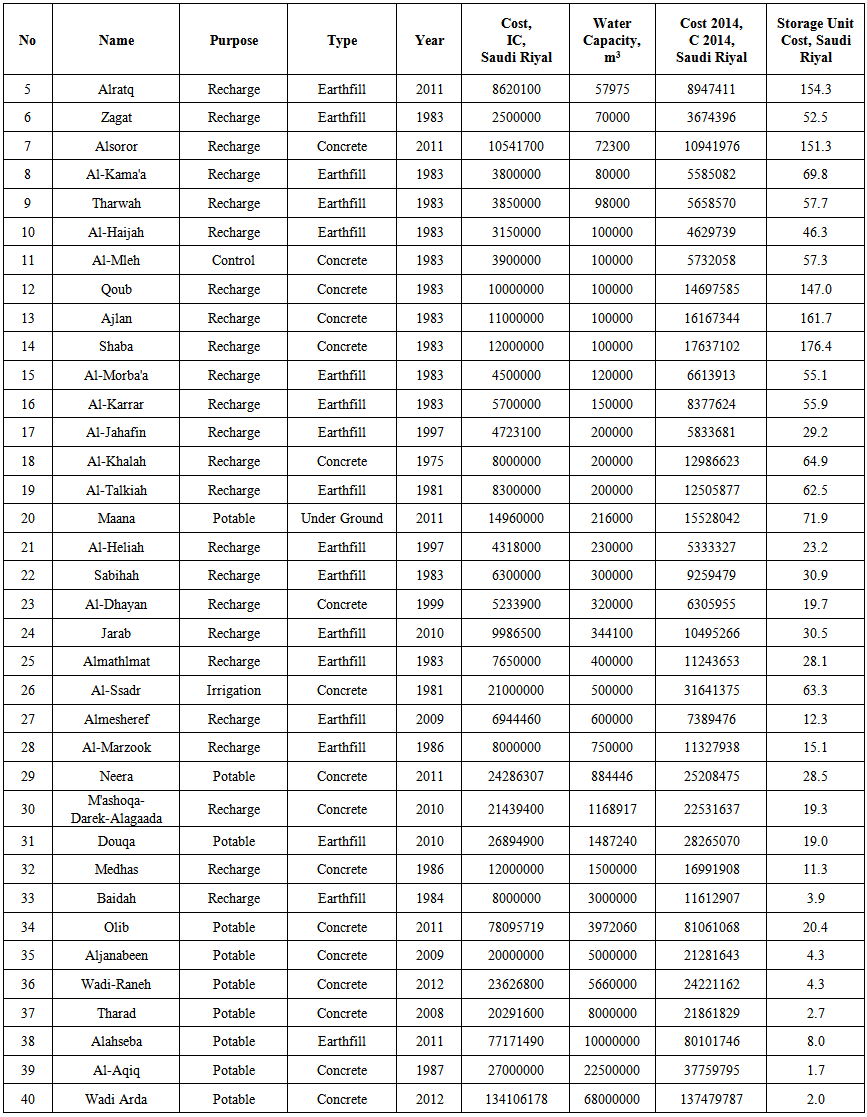 | Table 1. Data for Dams, Al-Baha Province (Cont.) |
References
| [1] | Ninth Development Plan, 2009 – 2014, Ministry of Planning, Kingdom of Saudi Arabia. |
| [2] | Dams under Construction in Al-Baha, Water Studies Department, Deputy Ministry for Water Affairs, Ministry of Water and Electricity, Kingdom of Saudi Arabia, 2011. |
| [3] | Dams in the Kingdom of Saudi Arabia, Ministry of Water and Electricity, Kingdom of Saudi Arabia, 2006. |
| [4] | World Economic and Financial Surveys, Tensions from the Two-Speed Recovery: Unemployment, Commodities, and Capital Flows, April 2011. World Economic Outlook (WEO), International Monetary Fund (IMF) Home Page, http://www.imf.org/external/pubs/ft/weo/2011/01/ - 61k –HTML (accessed January 11, 2013). (Website) |
| [5] | Saudi Arabian Monetary Agency, August 2014, Home Page, http://www.sama.gov.sa/Pages/Home.aspx (accessed August 23, 2014). (Website) |
| [6] | El-Hazek, A. N., 2013, "Cost of Dams in Al-Baha Province, Kingdom of Saudi Arabia", Journal of Environmental Science and Engineering B, David Publishing Company, USA, 2(2), 77-81. |
| [7] | El-Hazek, A. N., 2014, "Optimum Water Storage in Al-Baha, Kingdom of Saudi Arabia", American Journal of Environmental Engineering, Scientific & Academic Publishing, USA, 4(2), 19-24. |

























 Abstract
Abstract Reference
Reference Full-Text PDF
Full-Text PDF Full-text HTML
Full-text HTML
